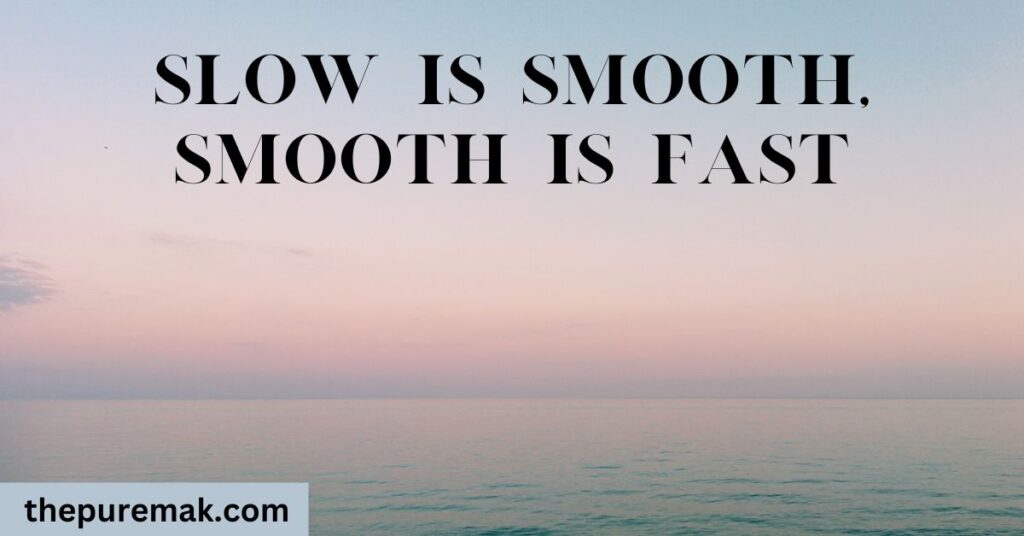
The key to seamless productivity could be obscure in today’s fast-paced world. We frequently discover ourselves engulfed in a maelstrom of due dates, multitasking, and unceasing bustle. However, what if there was a method to accomplish more with less effort? This brings us to the idea of “Slow is Smooth, Smooth is Fast.”
The secret to increasing productivity without sacrificing sanity is found in this intriguing phrase. We may do jobs more quickly and effortlessly if we embrace a slower pace and concentrate on flawless execution. Let’s explore this fascinating theory and see how it might completely transform how we think about productivity. Prepare to realize all of your potential; slow down to accelerate!
Contents
- 1 Understanding the Concept of Slow is Smooth; Smooth is Fast
- 2 The Benefits of Slowing Down in a Fast-Paced World
- 3 How to Apply Slow is Smooth, Smooth is Fast in Your Daily Life
- 4 Productivity Hacks to Help You Work Smarter, Not Harder
- 5 Tips for Maintaining a Balanced and Sustainable Pace
- 6 Real-Life Examples of Successful Implementation of Slow is Smooth, Smooth is Fast
- 7 Conclusion
- 8 FAQs
- 8.0.1 Q: What does “Slow is Smooth, Smooth is Fast” mean?
- 8.0.2 Q: How can I slow down in a fast-paced world?
- 8.0.3 Q: Is it possible to work smarter, not harder?
- 8.0.4 Q: How do I maintain a balanced pace without burning out?
- 8.0.5 Q: Can you give examples of successful implementation of Slow is Smooth, Smooth is Fast?
- 8.1 Latest Posts!
Understanding the Concept of Slow is Smooth; Smooth is Fast
To fully understand the tenet “Slow is Smooth, Smooth is Fast,” we need to change how we think about productivity. It’s about packing more than you can into every minute and racing through responsibilities. Rather, it’s about adopting a systematic and careful approach.
Fundamentally, this idea stresses the importance of being present in whatever we do. We may give something our whole attention and guarantee that it is completed accurately by slowing down and concentrating on it one task at a time. By doing this, we can steer clear of errors or have to go back later.
The Benefits of Slowing Down in a Fast-Paced World
- Slowing down greatly benefits a society that values speed and continual activity. We may all benefit from pausing, thinking, and recharging occasionally.
- We can completely engage in the present moment when we slow down. We need to appreciate our immediate surroundings’ little pleasures and beauty as we speed through life, multitasking nonstop and planning for the future. We become more conscious of our surroundings and value the tiny things frequently overlooked when we purposefully slow down.
- Additionally, slowing down gives us more room to reflect and come to wiser conclusions. It takes time for our thoughts to digest information and evaluate circumstances fully. If we step back from the daily chaos, we may clarify challenges and develop original answers.
- Reducing speed also contributes to a lower stress level. Burnout and exhaustion can result from modern civilization’s fast-paced, demanding nature. By purposefully adding breaks to our everyday schedules, such as meditation, time spent in nature, or hobbies, we give ourselves a much-needed break from the pressure that is always present.
How to Apply Slow is Smooth, Smooth is Fast in Your Daily Life
Incorporating the Slow is Smooth; Smooth is Fast principle into your everyday routine can lead to seamless productivity. To begin, pause to evaluate your speed and pinpoint places where you can reduce your speed. This could entail engaging in mindfulness exercises and giving your all to every work you perform.
Sort your to-do list by priority and urgency rather than going through it quickly. You can give a task your whole concentration and finish it more rapidly if you concentrate on it one at a time. Steer clear of multitasking; research indicates that it lowers productivity in general.
Utilizing Slow is Smooth; Smooth is Fast can also be achieved by taking regular daily pauses. Studies have indicated that brief rests enhance concentration and ingenuity.
Productivity Hacks to Help You Work Smarter, Not Harder
Greater effort and more time are required in today’s fast-paced world. What if I told you that being more productive sometimes means working more hours at the office? That’s correct: sometimes, working more intelligently rather than forcefully is the key to maximum productivity.
Setting priorities for your work is one useful trick. Prioritize the most urgent and significant tasks on your list of things to complete. This keeps you from overburdened with less important duties and helps you concentrate on high-value activities.
Dividing your job into smaller, more manageable portions is another helpful suggestion. By breaking a larger activity into smaller subtasks or establishing clear goals for each session, you may foster a sense of progress and success. Moreover, it becomes simpler to maintain motivation when you can observe actual outcomes.
Use technological tools that can help you optimize your workflow as well. Many tools, such as digital calendars, time-tracking applications, and project management software, are at our disposal to increase productivity.
Additionally, think about using time-blocking strategies. Set aside specified time slots during the day for various tasks or hobbies. This protects you from becoming sidetracked and helps you stay focused on each task without getting overworked or exhausted.
Finally, as part of your productivity approach, give self-care top priority. You may rejuvenate physically and psychologically by taking short pauses throughout the day, returning to work feeling invigorated and prepared to take on obstacles head-on.
Recall that being smarter at work entails maximizing productivity while preserving a good work-life balance outside of the workplace. So why keep circling when you can achieve effortless productivity with these easy tricks?
Tips for Maintaining a Balanced and Sustainable Pace
1. Prioritize and Delegate:
Effective task prioritization is one of the keys to keeping a steady and balanced pace. Evaluate your workload and decide which of the most crucial tasks need urgent attention. Assign less important or urgent duties to teammates or coworkers who can help you.
2. Set Realistic Goals:
Setting reasonable objectives that fit your timetable, skills, and resources is crucial. Take care not to overcommit yourself because this can eventually result in burnout and lower productivity.
3. Practice Time Management:
Retaining balance and sustainability can be greatly impacted by using efficient time management techniques. Divide more complex jobs into smaller, more manageable tasks, give each work a set amount of time, and try to minimize multitasking.
4. Take Regular Breaks:
Regular breaks throughout the day allow your body and mind to rest. Quick breaks can enhance well-being overall, creativity, and focus.
5. Nurture Healthy Habits:
Include physical activity, a balanced diet, enough sleep, and mindfulness techniques like deep breathing or meditation in your everyday routine. These routines play a major role in sustaining appropriate energy levels all day long.
6. Seek Support:
Never be afraid to ask for help when needed, whether via talking to mentors or confiding in friends or coworkers about difficulties at work.
7. Maintain Work-Life Balance:
Try to maintain a healthy work-life balance by drawing boundaries between your personal and professional obligations. This will help you avoid burnout and promote overall satisfaction.
Remember that maintaining equilibrium takes constant work; try several strategies until you discover the one that suits you the best!
Real-Life Examples of Successful Implementation of Slow is Smooth, Smooth is Fast
1. The Zen Master:
Consider the Zen master as an example. They move slowly and deliberately, approaching activities with purposeful tranquillity. They accomplish amazing accuracy and efficiency in their acts by doing this.
2. Olympic Runner:
Imagine an Olympic runner getting ready for a competition. They exercise methodically, not hurrying through their routines but concentrating on honing their form and technique. In the end, quicker times are achieved on the track with this systematic and slow approach.
3. Chef Extraordinaire:
A great chef knows that cooking takes time and careful attention to detail. They produce visually stunning and delectable culinary creations by painstakingly following step-by-step recipes and preparing each item.
4. Creative Genius:
“Slow is smooth, smooth is fast” is a philosophy many authors and artists follow when working on creative projects. They know creativity cannot be forced; it develops organically, given time to soak in.
5. Technology Innovators:
Many writers and artists operate on the tenet that “slow is smooth, smooth is fast” when producing their works of art. They understand that creativity develops naturally given time to soak in; it cannot be forced.
6. Business Tycoon:
Despite busy schedules, entrepreneurs like Richard Branson stress the significance of self-care to prevent burnout and rash judgments.
These real-world examples demonstrate how accepting slowness may boost productivity across various fields, from athletics to the arts, enabling people to do more while feeling comfortable.
Conclusion
It’s easy to get caught up in a rush and lose sight of what counts in today’s fast-paced environment when productivity is frequently judged by how much we can achieve in the shortest time. On the other hand, adopting the mindset that “Slow is Smooth, Smooth is Fast” can completely alter the game.
We may decrease mistakes, avoid burnout, and boost productivity by deliberately slowing down and concentrating on every task. Planning and prioritizing our tasks allows us to work more efficiently than harder.
We must be disciplined and mindful to incorporate this idea into our everyday lives. It entails living in the present rather than always moving forward quickly. It involves establishing reasonable objectives and allowing ourselves to pause when necessary.
FAQs
Q: What does “Slow is Smooth, Smooth is Fast” mean?
A: The adage “Slow is Smooth, Smooth is Fast” suggests that we can do activities more quickly and effectively by being deliberate and patient. It highlights how crucial quality is over speed.
Q: How can I slow down in a fast-paced world?
A: In a world where things move quickly, slowing down takes deliberate effort. Set priorities for your tasks and concentrate on one at a time to start. As much as possible, refrain from multitasking and take pauses to recharge. Use mindfulness exercises like meditation or deep breathing to help you remain composed and in the middle of the chaos.
Q: Is it possible to work smarter, not harder?
A: Definitely! Strategic planning, effective resource management, goal-setting grounded in reality, task delegation when required, and technological tools to automate repetitive chores are all components of working smarter. You can do more with less effort if you streamline your workflow and eliminate busy work and pointless distractions.
Q: How do I maintain a balanced pace without burning out?
A: Self-awareness and self-care are necessary for keeping a balanced pace. Make good food, frequent exercise, sound sleep, and spending time with loved ones your top priorities. To avoid burnout, establish boundaries between your personal and professional lives. Remember that your total well-being is as important as your job hours when determining your productivity.
Q: Can you give examples of successful implementation of Slow is Smooth, Smooth is Fast?
A: Of course! This is a principle that many prosperous people have adopted into their lives. For instance, Steve Jobs’s exact attention to detail was well-known, and it played a significant role in the success of Apple. Pro athletes frequently perform slow-motion drills several times before performing fast-paced competitive maneuvers. Word by word, writers meticulously construct sentences until they produce works of art that strike a chord with readers.






